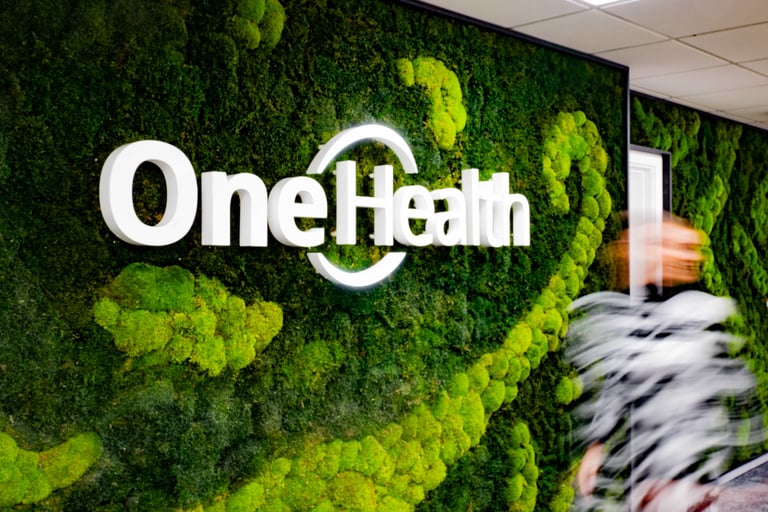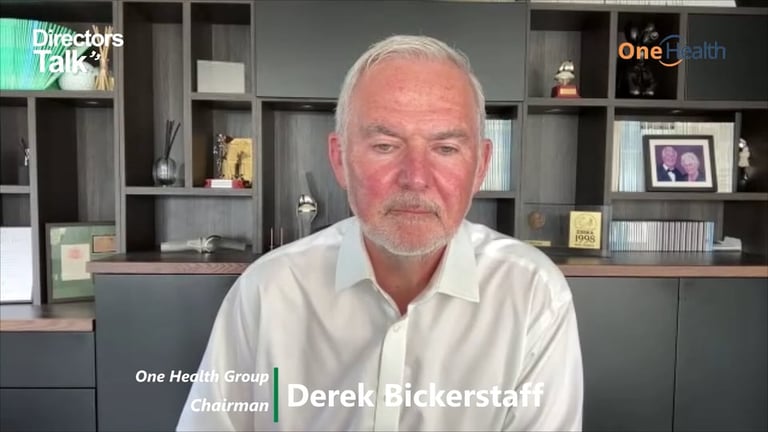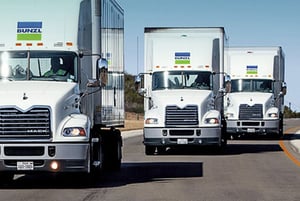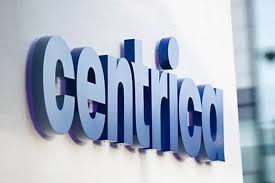One Health Group plc (LON:OHGR) Chairman Derek Bickerstaff caught up with DirectorsTalk to discuss the company’s strong first-half trading update and strategic growth plans focused on addressing NHS elective care backlogs.
Q1: Derek, a strong first half trading update just published with significant growth across all KPIs. Can you just take us through the key metrics?
A1: Whenever we consider One Health Group, we always look at the key drivers of growth. If you look at those key drivers, they are ‘have we got enough patients?’, ‘have we got enough surgeons to operate on those patients?’, ‘have we got enough operating capacity?’ and by that, I mean, ‘have we got access to operating facilities?’
So, have we got enough patients? If you look at the number of referrals we’ve had, then they’re up 16% on the same time last year. So, there’s plenty of patients coming to us and that’s not surprising, given the waiting list at 7.4 million.
Do we have enough surgeons? Again, we’ve recruited 14% more surgeons so we’re now up to 80 subspecialist surgeons to deal with our patients. In addition to that, we have about 40 or 50 anaesthetists as well so again, on that metric, we’re scoring well.
Lastly, do we have enough operating capacity? Again, we’ve increased our access to operating facilities by about 20% so we’re now up to 12 operating facilities.
It’s no surprise, therefore, that if you look at the number of procedures that we’re performing, that too has risen. That’s gone up 17% and similarly, this has driven up revenue to about 17% as well.
So, following a tremendous year last year, we’ve been able to continue our double-digit organic growth.
Q2: The strong growth in NHS patient referrals is being driven by patient choice. For those not familiar with One Health, can you briefly explain what it is that you do and why patient choice is so important to that?
A2: The One Health business model is that we provide elective surgical services to the NHS. Specifically, that means elective operating, i.e. operating patients who are on this huge waiting list. We specifically supply services in orthopaedics, in spinal surgery, in general surgery, gynaecology and in urology.
As you’ve seen from the previous metric, we have 80 surgeons, and we send them out into the community, to about 40 community clinics, and this is in the north of England and the Midlands. The patients are then seen in that clinic and then if they need an operation, then they’re taken to the 10 operating centres that we use, again, as near as possible to the patient.
So, we were able to provide a service to the patient and the GP throughout the full clinical pathway from initial referral right way through to final discharge. Everything is free at the point of delivery, which is consistent with obviously the NHS principles.
Now, this is driven by something called patient choice. Patient choice was developed in 2006 in the Tony Blair government and basically it was if patients were waiting too long to be seen in a local hospital, they could choose to go to a hospital further away if they wished to get treatment quicker. This was then opened out into the independent sector and in 2012, One Health got a contract for the whole of England to provide these services.
The providers in the independent sector quite rightly had to jump through many hoops with regards to clinical governance, business governance, financial governance so it’s very, very, very regulated.
So basically, patients can choose to see us from referral from their GP. Now, not many people know about this, and patient choice is poorly understood and is poorly taken up by the population, but it is being pushed by the government because the government see this as a way of getting waiting lists down.
One of the measures they’re taking is that they are widening the scope of the NHS app and so on the NHS app in the future, you’ll be able to have choice, you’ll be able to choose who you want to see.
How this works, it’s a bit like a Google search, really. So, if you go to see your GP and you’ve got a hip problem, your GP has tried all conservative measures and thinks that you need surgery. At that point, you will have the choice to be referred to the provider of your choice and so you go on to the ERS system, the electronic referral system and it’s like a Google search. You’ll be able to search for providers near your location and because One Health has 40 community clinics, we are inevitably pretty close to wherever that patient is looking.
The patient then comes to see us at our clinic. If they need an operation, our admin staff pick that up and then organise the operation in a local hospital, organise the follow-up consultations and organise all the rehabilitation. So, it’s a bespoke service for NHS patients.
We also get patients referred to us, not through patient choice, but also through trust referrals and this tends to happen in the third and fourth quarters of a year. Basically, trust hospitals are overwhelmed by the number of patients who choose them, they’re struggling to hit their targets by April and therefore they offload patients to us, and we just plug them in to our system. They’re seen in the community clinics and then they have surgery, as I’ve described earlier.
Q3: Aside from organic growth, an important part of your growth strategy is via surgical hubs. Can you explain this strategy and bring us up to date on progress with your first site?
A3: OK, so why are we growing surgical hubs? Well, over the wide geographic area that we serve, we’ve identified areas where there’s high demand and they tend to be relatively underprivileged areas and so aren’t served by independent private hospitals as well, because the private hospitals are focused really on providing private care.
So, we see patients in this area where there’s high density, high demand, no independent sector hospitals to offer choice, and the NHS facilities are not providing what should be required for them. So, into these areas, we’re going to drop a surgical hub.
What is a surgical hub? A surgical hub is not a hospital. Because we do all our consultations, our diagnostics, and our rehabilitation out in the community, we don’t need a hospital. What a surgical hub is, is purely a facility to operate in. So, basically beds, an operating theatre, and a recovery ward, and then all our patients from there are discharged back out into the community.
In the surgical hub, we’ll be doing the high tariff cases, what’s really been demanded in the NHS waiting list. So, high tariff cases like hip replacements, knee replacements, and simple spinal surgery so this will be very efficient, very productive.
The advantages of a surgical hub are, well, primarily for the patients. The patients have more choice. They don’t have to travel so far. The advantage for us as a company as well is that we get increased revenue because the patients that will be going through the surgical hub will be additional patients. We work very well with our independent sector partners, there’s no need to remove patients from them, this is additional capacity for the NHS to try and get those waiting lists down.
With those additional patients, we will get increased revenue. We also get increased profit because whilst we’re internalising all the cost of the operation instead of using independent sector hospitals, we also internalise the profits of that. We’ve estimated that each surgical hub will generate roughly £6 million additional revenue and about £2 million of profit. This is what we term our strategic growth. This is an additional to the organic growth, which as I’ve explained earlier is double digit and that will carry on relentlessly.
As for the update, we’ve got planning already for our first hub, which is going to be in the Scunthorpe area. It’s just at this stage, just going through, when we received planning, there were some provisions with regards to some environmental concerns. We thought we dealt with that at pre-planning, but not quite sufficiently, obviously. So, we’ve dealt with those provisions, feedback we’re getting is very positive, this is going to go back into for a planning decision later on this month. We’re very confident we’ll get it and then once we get it, we’re well underway to putting a spade in the ground.
We’ve not wasted this time. We’ve actually been working hard at decreasing the cost base of the strategic hub, we’ve been working with regards to recruitment in the hub and we’ve also been working with the local health communities and commissioners. So, time hasn’t been wasted.
We’re confident that before the end of the year, we’ll get a spade in the ground. It’s a 12-month build so we should get the surgical hub open towards the end of 2026.
Q4: Now you’ve confirmed that you’re on track to hit financial targets for the full year. Can you confirm for us what those market forecasts are?
A4: We are confident about the future, and we are on track to deliver both at revenue and underlying EBITDA levels in line with the market forecasts. These forecasts have us delivering revenues for the year ending March ‘26 of £29.6 million and also growing our underlying EBITDA by nearly 14% to £2.3 million. So, we’re confident we will be able to achieve those forecasts.
Q5: It’s a great story but in your statement, you say that you look forward in confidence. For someone new to One Health investment case, can you just conclude with a short outline as to why the business is exciting and a company on AIM that investors should take time to understand further?
A5: This goes back really to the main driver of growth, which is patients, and at the minute we have a waiting list for elective care of 7.4 million people, which is a vast amount of people. Around 2010, the waiting list got down to about 1.8 million and that’s the point at which it should be.
To achieve this goal, to get the waiting list down, the government have set themselves some very, very strict targets. They want to get down to 92% of patients only waiting 18 weeks by 2029, which is at the time of the next election. That’s been the statutory requirement for elective surgery, it really hasn’t been met for over a decade, but it’s a hugely difficult task.
The government have reconfirmed that these commitments over the weekend in the medical press, they’ve doubled down on these requirements.
So, it’s a hugely difficult task but the government has also confirmed that they want to work with the NHS to try and achieve these targets, and there have been multiple references in the press about this.
Notably, in January 2025, the Prime Minister and the Secretary of State for Health announced that they made a contract with the independent sector to use their capacity to get the waiting list down. This was reinforced only over the weekend in an article on Friday in the Times by the Minister of Health saying that they have no ideological problem with using the independent sector and they’ll use capacity wherever it’s available.
In addition, we have the 10-year plan announced by the Secretary of State. Within that, again, reinforcing wanting to work with the independent sector, wanting surgical hubs, and also wanting care further out into the community, which is effectively the One Health Group business plan.
So, we’re very confident that we have government support with regards to the type of model that we have created, which is community care with access to more underprivileged people, people who can’t really access NHS care easily.
However, the problems are huge for them. If you look at the short term, with winter coming and with looming doctor strikes, inevitably the waiting list will go up, despite the government having worked well recently to get the waiting list down. Unfortunately, they’ve gone up over the last three months so in the short term, there’s a problem.
In the medium to long term, there’s an even bigger problem with structural reform being required in the NHS, which is part of the 10-year plan and is recognised by the government and indeed is recognised by all political parties.
If you look at what the NHS provides, it provides emergency care, primary care, mental health, cancer care, care of chronic disease. These are hugely difficult problems. But elective care, we believe, of all those problems, is the easiest one to solve. It’s very process orientated.
So, we believe that what we’re providing the NHS, which is a productive, inefficient, patient-friendly service, is ideally placed to deal and help the government deal with their elective waiting list. You’ve got to remember, underlying all this are the demographics. The population is only growing, and it is only getting older and so the demands will only be increased.
So yes, we do look forward with confidence. We think we have a model which fits the aspirations of this government and any future government fits very neatly into providing a very efficient and productive service.














































